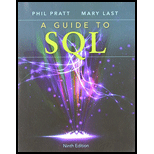
A Guide to SQL
9th Edition
ISBN: 9781111527273
Author: Philip J. Pratt
Publisher: Course Technology Ptr
expand_more
expand_more
format_list_bulleted
Concept explainers
Question
Chapter 1, Problem 9TD
Program Plan Intro
SELECT statement:
It is used to retrieve information from the table or
Syntax:
SELECT * FROM table_Name;
Expert Solution & Answer
Trending nowThis is a popular solution!

Students have asked these similar questions
Considering the TM example of binary sum ( see attached)do the step-by-step of execution for the binary numbers 1101 and 11.
Feel free to use the Formal Language Editor Tool to execute it;
Write it down the current state of the tape (including the head position) and indicate the current state of the TM at each step.
I need help on inculding additonal code where I can can do the opposite code of MatLab, where the function of t that I enter becomes the result of F(t), in other words, turning the time-domain f(t) into the frequency-domain function F(s):
I need help with the TM computation step-by-step execution for the binary numbers 1101 and 11.
Formal Language Editor Tool can be used to execute it; Write it down the current state of the tape (including the head position) and indicate the current state of the TM at each step;
Chapter 1 Solutions
A Guide to SQL
Ch. 1 - Prob. 1TDCh. 1 - Prob. 2TDCh. 1 - Prob. 3TDCh. 1 - Prob. 4TDCh. 1 - Prob. 5TDCh. 1 - Prob. 6TDCh. 1 - Prob. 7TDCh. 1 - Prob. 8TDCh. 1 - Prob. 9TDCh. 1 - Prob. 10TD
Ch. 1 - Prob. 11TDCh. 1 - Prob. 1CATCh. 1 - Prob. 2CATCh. 1 - Prob. 3CATCh. 1 - Prob. 4CATCh. 1 - Prob. 5CATCh. 1 - Prob. 6CATCh. 1 - Prob. 7CATCh. 1 - Prob. 8CATCh. 1 - Prob. 9CATCh. 1 - Prob. 10CATCh. 1 - Prob. 11CATCh. 1 - Prob. 12CATCh. 1 - Prob. 13CATCh. 1 - Prob. 14CATCh. 1 - Prob. 1SCGCh. 1 - Prob. 2SCGCh. 1 - Prob. 3SCGCh. 1 - Prob. 4SCGCh. 1 - Prob. 5SCGCh. 1 - Prob. 6SCGCh. 1 - Prob. 7SCGCh. 1 - Prob. 8SCGCh. 1 - Prob. 9SCGCh. 1 - Prob. 10SCGCh. 1 - Prob. 11SCGCh. 1 - Prob. 12SCGCh. 1 - Prob. 13SCG
Knowledge Booster
Learn more about
Need a deep-dive on the concept behind this application? Look no further. Learn more about this topic, computer-science and related others by exploring similar questions and additional content below.Similar questions
- Ensure you answer the question asked at the end of the document. Do not just paste things without the GNS3 console outputsarrow_forward"Do not use AI tools. Solve the problem by hand on paper only and upload a photo of your handwritten solution."arrow_forward"Do not use AI tools. Solve the problem by hand on paper only and upload a photo of your handwritten solution."arrow_forward
- "Do not use AI tools. Solve the problem by hand on paper only and upload a photo of your handwritten solution."arrow_forward"Do not use AI tools. Solve the problem by hand on paper only and upload a photo of your handwritten solution."arrow_forwardSolve this "Do not use AI tools. Solve the problem by hand on paper only and upload a photo of your handwritten solution."arrow_forward
- "Do not use AI tools. Solve the problem by hand on paper only and upload a photo of your handwritten solution."arrow_forward"Do not use AI tools. Solve the problem by hand on paper only and upload a photo of your handwritten solution."arrow_forwardSpecifications: Part-1Part-1: DescriptionIn this part of the lab you will build a single operation ALU. This ALU will implement a bitwise left rotation. Forthis lab assignment you are not allowed to use Digital's Arithmetic components.IF YOU ARE FOUND USING THEM, YOU WILL RECEIVE A ZERO FOR LAB2!The ALU you will be implementing consists of two 4-bit inputs (named inA and inB) and one 4-bit output (named out). Your ALU must rotate the bits in inA by the amount given by inB (i.e. 0-15).Part-1: User InterfaceYou are provided an interface file lab2_part1.dig; start Part-1 from this file.NOTE: You are not permitted to edit the content inside the dotted lines rectangle. Part-1: ExampleIn the figure above, the input values that we have selected to test are inA = {inA_3, inA_2, inA_1, inA_0} = {0, 1, 0,0} and inB = {inB_3, inB_2, inB_1, inB_0} = {0, 0, 1, 0}. Therefore, we must rotate the bus 0100 bitwise left by00102, or 2 in base 10, to get {0, 0, 0, 1}. Please note that a rotation left is…arrow_forward
arrow_back_ios
SEE MORE QUESTIONS
arrow_forward_ios
Recommended textbooks for you
 A Guide to SQLComputer ScienceISBN:9781111527273Author:Philip J. PrattPublisher:Course Technology Ptr
A Guide to SQLComputer ScienceISBN:9781111527273Author:Philip J. PrattPublisher:Course Technology Ptr

A Guide to SQL
Computer Science
ISBN:9781111527273
Author:Philip J. Pratt
Publisher:Course Technology Ptr
